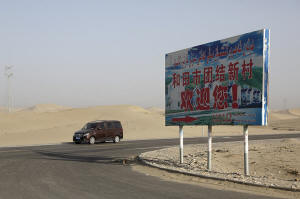Rights group says global brands are at risk of links to forced labor in
China's minerals industry
[June 11, 2025] LONDON
(AP) — Several global brands are among dozens of companies at risk of
using forced labor through their Chinese supply chains because they use
critical minerals or buy minerals-based products sourced from the
far-western Xinjiang region of China, an international rights group said
Wednesday.
The report by the Netherlands-based Global Rights Compliance says
companies including Avon, Walmart, Nescafe, Coca-Cola and paint supplier
Sherwin-Williams may be linked to titanium sourced from Xinjiang, where
rights groups allege the Chinese government runs coercive labor
practices targeting predominantly Muslim Uyghurs and other Turkic
minorities.
The report found 77 Chinese suppliers in the titanium, lithium,
beryllium and magnesium industries operating in Xinjiang. It said the
suppliers are at risk of participating in the Chinese government's
“labor transfer programs," in which Uyghurs are forced to work in
factories as part of a long-standing campaign of assimilation and mass
detention.
Commercial paints, thermos cups and components for the aerospace, auto
and defense industries are among products sold internationally that can
trace their supply chains to minerals from Xinjiang, the report said. It
said that companies must review their supply chains.
“Mineral mining and processing in (Xinjiang) rely in part on the state’s
forced labor programs for Uyghurs and other Turkic people in the
region,” the report said.

The report came as China and the United States, the world’s two largest
economies, said that they have agreed on a framework to get their trade
negotiations back on track after a series of disputes that threatened to
derail them. The two sides on Tuesday wrapped up two days of talks in
London that appeared to focus on finding a way to resolve disputes over
mineral and technology exports that had shaken a fragile truce on trade
reached in Geneva last month.
Asked about the report, the Chinese Foreign Ministry said that “no one
has ever been forcibly transferred in China’s Xinjiang under work
programs.”
“The so-called allegation of forced labor in China’s Xinjiang region is
nothing but a lie concocted by certain anti-China forces. We urge the
relevant organization to stop interfering in China’s internal affairs
and undermining Xinjiang’s prosperity and stability under the guise of
human rights,” ministry spokesperson Lin Jian said Wednesday.
[to top of second column] |

A car drives through a desert where a signboard which reads "Welcome
to the Hotan Unity New Village" is seen on display in Hotan, in
western China's Xinjiang region on Sept. 21, 2018. (AP Photo/Andy
Wong, File)
 The named companies didn't
immediately comment on the report.
A U.N. report from 2022 found China may have committed crimes
against humanity in Xinjiang, where more than 1 million Uyghurs are
estimated to have been arbitrarily detained as part of measures that
the Chinese government said were intended to target terrorism and
separatism.
The Chinese government has rejected the U.N. claims and defended its
actions in Xinjiang as fighting terror and ensuring stability.
In 2021, then U.S. President Joe Biden signed a law to block imports
from the Xinjiang region unless businesses can prove the items were
made without forced labor. The law initially targeted solar
products, tomatoes, cotton and apparel, but the U.S. government
recently added new sectors for enforcement, including aluminum and
seafood.
Many of China's major minerals corporations have invested in the
exploration and mining of lithium, a key component for electric
vehicle batteries, in Xinjiang, Global Rights Compliance said.
Xinjiang is also China's top source of beryllium, a mineral used for
aerospace, defense and telecommunications, its report said.
A recent report by the International Energy Agency said that the
world’s sources of critical minerals are increasingly concentrated
in a few countries, notably China, which is also a leading refining
and processing base for lithium, cobalt, graphite and other
minerals.
All contents © copyright 2025 Associated Press. All rights reserved
 |